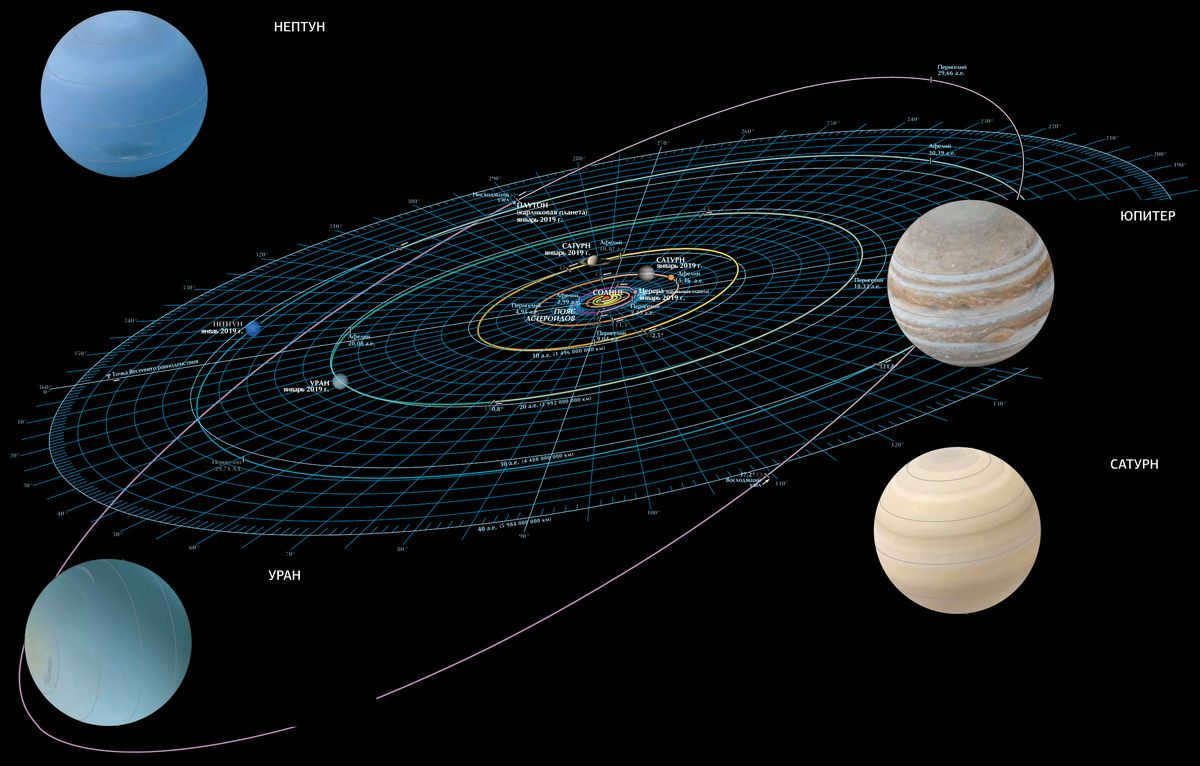
To begin with, let’s establish the meaning of orbits and their purpose.
The paths or trajectories of motion followed by the planets are known as orbits. These orbits are defined within a predetermined coordinate system.
All celestial bodies in the solar system revolve around the Sun along their respective orbits. These orbits serve as the reference coordinate system. It’s important to note that each celestial body has its own unique orbit and they do not follow each other. Additionally, these orbits vary in length and extent, which has a direct impact on the climate and surface temperature of the celestial bodies.
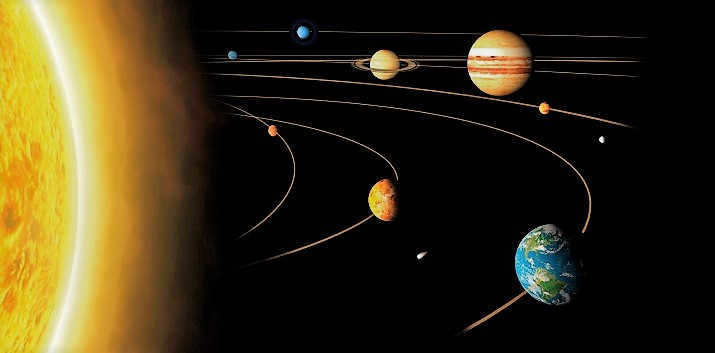
Characteristics of a planetary orbit
Each orbit in the solar system possesses unique characteristics that determine its shape, size, and position in space.
In the field of astronomy, the Keplerian elements are commonly used to describe an orbit. These elements include:
- The major semi-axis, which is a geometric parameter that defines the size of the orbit. It is formed by the intersection of the plane with the surface of a circular cone.
- Eccentricity, which is a numerical value that indicates the deviation of the orbit from a perfect circle.
- Inclination, which refers to the angle between the plane of the orbit and a reference plane.
- The pericenter argument is the angle between the directions from the center to the ascending node of the orbit. The pericenter itself is defined as the point on the orbit closest to the attracting center.
- The longitude of the ascending node is a mathematical description of the line of the orbital plane in relation to the reference plane.
- The mean anomaly is the result of the average motion of the body multiplied by the time interval from the pericenter. It maintains a consistent angular velocity.
Paths traced by the planets in the solar system
Undoubtedly, the Sun is positioned at the heart of our system. In fact, it encompasses the majority of the system’s mass. Through its powerful gravitational pull, it draws in heavenly bodies.
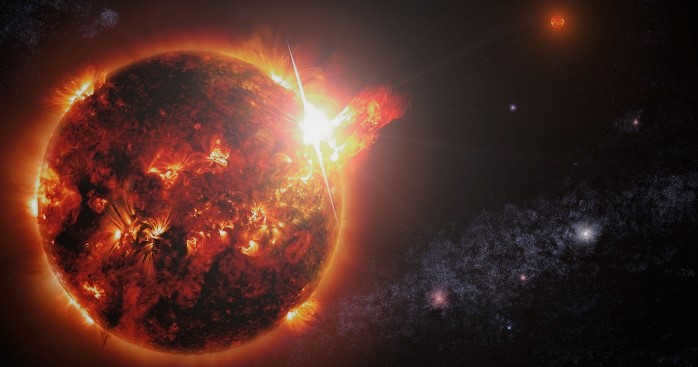
It should be mentioned that a considerable amount of celestial bodies within the solar system orbit in a similar region. This region is known as the ecliptic. There are other objects that deviate from this region and have a greater inclination angle.
All the planets, as well as numerous other bodies, orbit the Sun in a counterclockwise direction. Interestingly, the majority of planets also move in this same direction around the central star. The exceptions to this are Venus and Uranus, which have an opposite course.
As the distance from the Sun increases, the gap between the orbits of objects becomes greater.

From the perspective of astronomers, planets are in motion along an elliptical path. Essentially, they traverse a closed curve within a plane. The point where the Sun is located serves as one of the points on this ellipse. The closer a celestial body is to the Sun, the faster its rotational speed. As a result, it has a shorter period of revolution, or in simpler terms, a shorter year.
The planets in our solar system
Interestingly, our solar system is often classified into two distinct regions: the inner zone and the outer zone.
The inner zone consists of the asteroid belt and the planets in the Earth group, which include Mercury, Venus, Mars, and of course, Earth.
The outer zone is located beyond the Earth group and is home to four gas giants.
Furthermore, all objects within our solar system can be categorized into three types:
The composition of our solar system has been officially recognized by the International Astronomical Union, and it consists of a total of eight planets: Mercury, Venus, Earth, Mars, Jupiter, Saturn, Uranus, and Neptune.
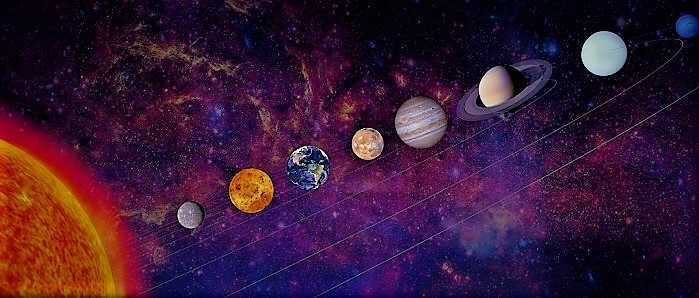
Planetary Arrangement
You might be wondering, what exactly is planetary arrangement and why is it so fascinating?
When it comes to astronomy, the term arrangement refers to how the Sun, planets, and other celestial bodies are positioned in relation to each other. This concept is particularly relevant to the solar system.
Based on their motion, we can distinguish between the arrangement of the lower and upper planets.
When viewed from our planet, the lower planets, specifically Mercury and Venus, exhibit a variation in their appearance known as phases.
These planets orbit relatively close to the Sun, with their maximum distance from it occurring either to the east or west. Their direction of elongation, whether it be towards the east (evening) or west (morning), determines the specific type of elongation they are experiencing.
Elongation refers to the angular position of the planet in relation to the Sun.
The movement of the planets below is in a retrograde direction, meaning east to west.
When a planet is positioned between the Earth and the Sun, it is referred to as a lower conjunction.
Conversely, the planets can also move in a direct manner, that is, from west to east. When the Sun is positioned between the Earth and the planet, an upper conjunction occurs.
Arrangement of the celestial bodies above
The arrangement of the celestial bodies above is comparable to that of the celestial bodies below. By analogy, there is both forward and backward motion. However, the primary difference lies in the slower pace of movement. Consequently, there comes a point when the Sun catches up to the planet, resulting in their convergence. Moreover, during this period, the Sun is positioned between the Earth and the planet.
During the backward motion, the planet reaches a point directly opposite to the Sun’s position. This moment is commonly referred to as opposition. It is during this phase that the Earth is situated between the Sun and the planet.
The planet’s location at a 90-degree angle from the Sun towards the east is known as the eastern quadrature. Similarly, a comparable position towards the west is referred to as the western quadrature.
The upper planets exhibit a continuous motion that does not involve any phase changes. These planets always present their illuminated side towards the Earth.
Interestingly, the movement of the Moon aligns with the arrangement of the upper planets.
Admittedly, the movement of the upper planets is not observable from Earth.
In the field of astronomy, there are two recognized categories of planetary orbital periods.
Sidereal period refers to the time it takes for a planet to complete one orbit around the Sun. In simpler terms, it is the duration of a planet’s year as measured by Earth’s days or years.
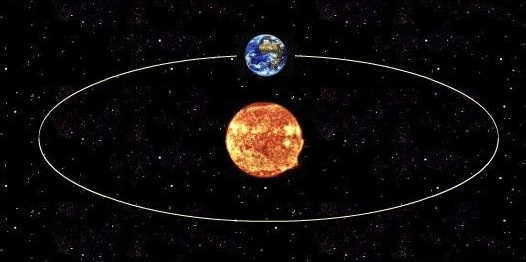

The time it takes for a planet to rotate and return to the same point from the observer’s position is called the synodic period. This calculation is made with the observer located on Earth.
Compared to the sideric period, the synodic period is more commonly used by astronomers due to its accessibility.
However, determining the synodic period can be challenging. Firstly, the Earth’s revolution around the Sun introduces inaccuracies and unevenness in the observed motion of the planets. Additionally, the backward motion of the planets must be taken into account.
The orbits of the planets are one of the many distinctive features of the Universe. Undeniably, exploring and observing them is captivating. The cosmos is filled with countless astonishing phenomena. It is safe to say that there are bound to be even more enthralling discoveries waiting to be made.
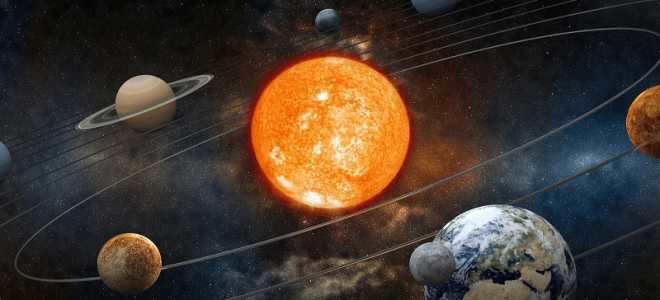
In essence, the movement of the planets within our solar system can be characterized by two main motions. Firstly, the planets undergo revolution around the Sun, completing their orbits in a regular and predictable manner. Secondly, in addition to this revolution, the planets also engage in another motion – they orbit around the galactic center, which adds another layer of complexity to their celestial paths.
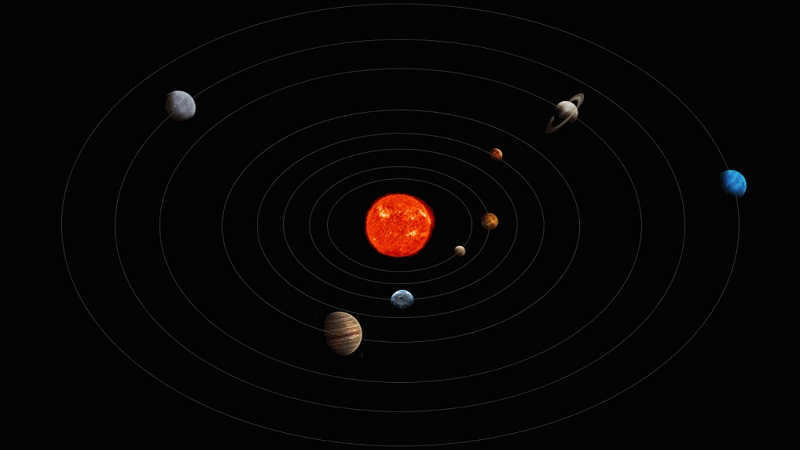
In ancient times, it was believed that our planet was the center of the world. However, over time, humans have come to realize that this is not the case.
Nicolaus Copernicus created the heliocentric system of the world, which states that all planetary bodies, including Earth, orbit around the Sun.
Tycho Brahe made a significant contribution to the field of astronomy by observing celestial bodies. From his observations, mathematician Johannes Kepler derived his famous laws. Additionally, Newton discovered the law of universal gravitation, which greatly influenced the understanding of elliptical orbits of celestial objects.

The principles governing the motion of planets according to Johannes Kepler
As we know, Johannes Kepler established three fundamental laws for each planet:
- Each planet follows an elliptical orbit, with the Sun located at one of the foci.
- The planet moves in a plane that passes through the center of the Sun, and the radius vector connecting the planet and the Sun sweeps equal areas in equal time intervals.
- The squares of the periods of the planets’ orbits around the Sun are proportional to the cubes of the semi-major axes of their orbits, allowing for the calculation of the planets’ speeds and the time taken for a complete revolution around the Sun.
It is important to note that each planetary body has its own unique period of circulation around the main luminary. For instance, the Earth completes this journey in 365 days (a year), whereas Mercury accomplishes it in just 88 Earth days. On the other hand, Jupiter takes approximately 11.9 years, and Pluto’s journey spans a staggering 247.7 years.
Furthermore, each planet also rotates on its own axis at a distinct speed.
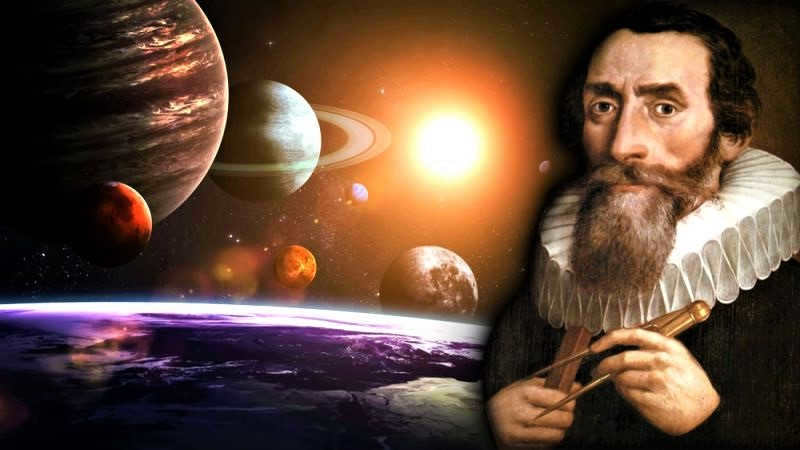
Movement of the planets closer to Earth
Based on the nature of their movement and their position in relation to the Earth’s orbit, we can differentiate between the planets that are closer to the Sun (Mercury, Venus) and the planets that are farther away (all the others).
It is interesting to note that the planets closer to the Sun do not stray far from it and can be found either to the east or to the west of it.
This is what we call elongation, which refers to the maximum angular distance from the central star. When a planet is at its furthest distance to the east, it is known as the eastern (evening) elongation, and when it is at its furthest distance to the west, it is known as the western (morning) elongation.
In fact, once it has reached that point, the planet becomes invisible – known as the superior conjunction. To put it simply, during this time, the Sun is positioned between it and the Earth, blocking our view.
Afterwards, the celestial object once again reaches the moment of eastern elongation, pauses, and begins its retrograde motion. And so, the cycle continues.
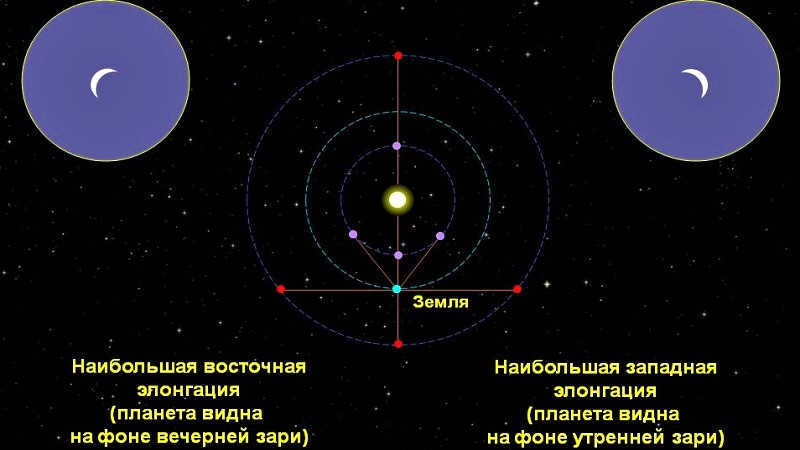
Motion of the Upper Planets
In reality, the movement of the upper planets is similar to that of the inner objects in our solar system. They exhibit a combination of direct and retrograde motion on the celestial sphere. When they are in the west after sunset, they move in a direct path, just like the Sun. However, the speed of the outer planets is slower. As they catch up with the Sun, they align with it and then the Sun surpasses the planetary object, causing it to appear in the east.
As a result, the planet decelerates, comes to a stop, and then begins to move in a backward direction. At a certain point, it reaches a position in the sky opposite to the location of the Sun, which is known as opposition. During this time, the Earth is positioned between the central star and the planet.
Meanwhile, following a specific time interval, the planet halts and alters its course once more. Essentially, the pattern recurs.
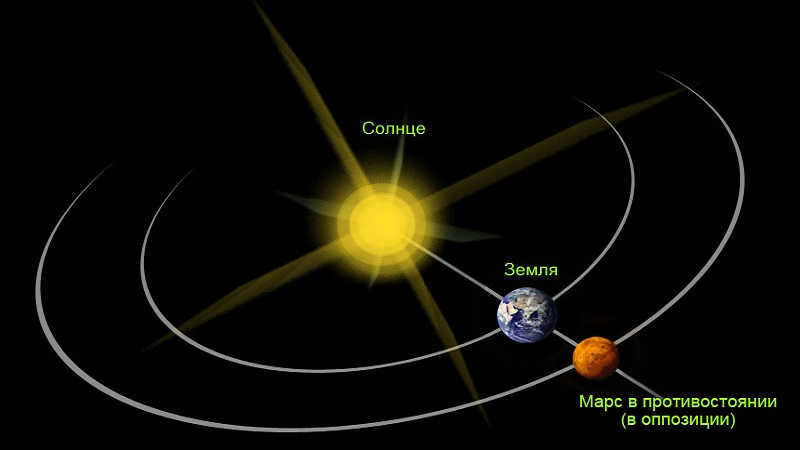
It is important to note that the positions of the planets have no connection to the Earth’s daily rotation. It is fascinating to observe how celestial bodies interact and move. Everything related to them is intriguing, especially because our Earth is directly influenced by these phenomena. We are subject to the laws of the Universe, which we strive to understand.

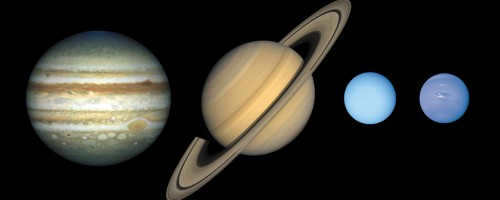
In ancient times, the planets were categorized into lower and upper planets based on their movement among the stars. The lower planets consist of Mercury and Venus, which orbit the Sun closer than Earth. The upper planets include all other planets whose orbits are situated outside of Earth’s orbit. A more significant scientific distinction is the division of the planets into inner and outer planets. The inner planets consist of those that orbit within the belt of smaller planets, namely Mercury, Venus, Earth, and Mars. These planets are also referred to as the terrestrial group planets. On the other hand, the outer planets are situated beyond the ring of minor planets and include Jupiter, Saturn, Uranus, Neptune, and Pluto. With the exception of Pluto, they are also known as giant planets due to their significant size.
Newton’s law of gravitation describes the mutual attraction between the planets and the Sun. The planets move in elliptical orbits around the Sun, following Kepler’s laws. However, the gravitational pull between the planets complicates their motion, making it difficult to calculate their positions in the sky and their distances from the Sun in celestial mechanics. This becomes even more challenging when trying to calculate these positions far in advance or in the past. Fortunately, modern mathematical theories allow us to accurately calculate the positions of the planets in the sky, even several millennia ago, with greater precision than astronomers in that time period could achieve through direct observations.
Table 1. – Geometric and mechanical characteristics of the primary planets (according to 1973 data).
Overall features of the celestial bodies.
The apparent brightness of the planets that were known in ancient times is just as impressive as that of the brightest stars, and Venus, Mars, and Jupiter outshine them. Among the planets that have been discovered more recently, only Uranus can be seen with the naked eye. To the naked eye, all the planets, like the stars, appear as bright points of light, but with a small telescope, you can see the disk of all the planets (except for the distant Pluto), which was first observed by Galileo in 1609. Venus and Mercury have phases similar to those of the Moon, ranging from “full” to a thin crescent or complete invisibility during a lower conjunction with the Sun (see Configurations). The outer planets do not undergo complete phase changes (Mars has no more than 47 degrees of illumination, Jupiter 11 degrees, etc.). The phases and angular sizes of the planets’ disks vary depending on the relative positions of the planets, the Sun, and the Earth, as well as the distances between the planets and the Earth. Calculating the actual sizes of the planets based on their angular sizes is not difficult, since the distances from the planets to the Earth are known with sufficient accuracy. However, measurements of the planets’ angular sizes using telescopes are subject to systematic errors that are difficult to eliminate, sometimes amounting to 1% of the measured value.
The characteristics of the big planets, including their geometric, mechanical, and physical properties, can be found in Tables 1 and 2.
Table 2. – Physical characteristics of the big planets (according to data from 1973).
Information about the surface, rotations, and mapping of the planets.

Radar technology allows for the creation of a comprehensive map detailing the radio albedo of the planet. By analyzing the signal returned to Earth, radar can differentiate the portions of the signal that are reflected by various locations on the planet’s surface. Additionally, radar’s precise distance calculation capabilities enable the detection of the planet’s surface relief, particularly in areas near the center of the visible disk. As a result, the relief of Venus and Mars, among other planets, has been successfully determined.
The weight and thickness of the celestial bodies.
The examination of the patterns of movement of the satellites of the planets based on the law of universal gravitation enables us to accurately ascertain the mass of the planets. For planets like Mercury, Venus, and Pluto, which lack satellites, their masses are determined through the perturbations they induce in the movements of other celestial bodies, primarily comets and man-made space probes (with the latter case exhibiting particularly high precision). In addition to Venus and Mercury, the mass of Mars has also been determined using this method, by analyzing the movements of its natural satellites. By knowing the mass of a planet and its size, we can calculate its average density, the acceleration of gravity on its surface, and the escape velocity, which is the critical velocity (also known as cosmic velocity) at which an object can permanently leave the planet (the escape velocity is calculated at the planet’s surface).
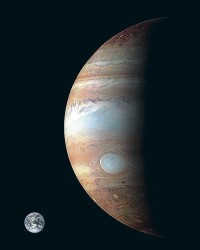
Here is a comparison of the sizes of Earth (located at the bottom left) and Jupiter.
The detection of a gaseous envelope surrounding planets is easily observable from Earth. This can be seen through the darkening of the planet’s edges, the gradual fading of the star when the planet passes in front of it, and the presence of cloud formations. By conducting photometric measurements, we can determine the reflectivity of the planet or its various parts, known as albedo. A high albedo indicates the presence of a strong atmosphere. By studying the albedo value and the changes in the planet’s brightness during different phases, we can analyze the quantitative characteristics of the planet’s atmosphere, such as its optical thickness and extent, using the principles of light scattering. Soviet astronomers N. P. Barabashov, V. G. Fesenkov, and V. V. Sharonov made significant contributions to this field in the 20th century. When interpreting such observations, scientists also consider the polarization of the planet’s light. However, it is important to note that the presence of solid and liquid particles in the atmosphere (aerosols) can greatly affect the scattering of light and potentially provide inaccurate information about the gas composition of the planet’s atmosphere. For example, until the mid-60s, the thickness of Mars’ atmosphere was overestimated by a factor of 10-20. Additionally, measurements of reflectivity, color, and polarization of light from different areas of the planet’s surface do not definitively answer questions about the nature of these areas.
The elasticity of the gases at the base of a planet’s atmosphere determines the power of the atmosphere. This power is measured in millibars (mbar), which is the value that a barometer-aneroid would indicate on the planet’s surface. It is important to note that this value does not necessarily represent the actual atmospheric pressure on the planet’s surface, as that depends on the acceleration of gravity. However, it allows for a direct comparison between the planet’s atmosphere and Earth’s atmosphere, as well as the calculation of the total mass of the planet’s gas envelope. The power of the atmosphere, or any gas within it, can be described by a special value in m-atm or cm-atm. This value represents the height to which the gas would extend if it had a density corresponding to a pressure of 1 atm, 1013 mbar, and a temperature of 0 o C. On Earth, this value is approximately 8000 m-atm. On Mercury, it is 1-3 cm-atm. On Mars, the atmospheric pressure at the surface is 5-8 mbar according to aneroid measurements. On Venus, the atmospheric pressure is about 100 atm. Giant planets typically have very powerful atmospheres.
The molecular absorption bands in the spectrum of solar radiation passing through a planet’s atmosphere can be used to determine the chemical composition of the atmosphere. However, it is challenging to separate these bands from those caused by light passing through Earth’s atmosphere when observing from the surface. Balloon observations can help overcome this difficulty. This method is effective for detecting gases in planetary atmospheres that are either absent or present in small quantities in Earth’s atmosphere, such as carbon dioxide (CO2), methane (CH4), ammonia (NH3), hydrogen (H2), water vapor (H2O), and oxygen (O2). However, gases like helium (Ne), nitrogen (N2), and argon (Ar), which have absorption bands in the far ultraviolet part of the spectrum, are difficult to detect. Prior to the space age, it was already known that Venus and Mars have CO2, and the outer planets have molecular hydrogen H2, methane (CH4), and ammonia (NH3). It is also assumed that there is a significant amount of helium in these atmospheres, similar to the composition of the Sun’s atmosphere.
The exploration of space has revolutionized the way we study planetary atmospheres. One innovative technique involves measuring the attenuation of radio signals transmitted from space probes as they pass behind planets. This attenuation is caused by the absorption of signals in the planet’s atmosphere. By analyzing this data, scientists can derive a “height scale” of the atmosphere and determine the ratio of temperature (T) to the average molecular weight (m). However, this method is most effective for studying rarefied atmospheres or the upper layers of more dense atmospheres.
Another approach involves direct contact between space probes and a planet’s atmosphere. This method has proven to be incredibly effective in gathering valuable data. For example, in the 1960s, the Soviet Union’s “Venera” series of probes successfully descended to Venus and conducted experiments that provided insight into the planet’s atmosphere. By measuring the intensity of specific molecular bands in the planet’s spectrum, scientists were able to determine the distance to the planet’s surface along the probe’s trajectory. This allowed them to create detailed maps of the planet’s relief.
Similar experiments were carried out with the Mars-3 and Mars-5 probes (Soviet Union) and the Mariner-9 probe (USA) on Mars. The rotation of the planet beneath the satellite’s orbit allowed for different parts of the surface to be observed. As a result, scientists were able to determine the relief of Mars with an impressive level of accuracy, down to several hundred meters, across a large portion of its surface.
By examining the temperature and chemical makeup of a planet’s atmosphere, specifically looking for the presence of oxygen and water, we can determine if life is possible. Based on current knowledge about Mars, it can be inferred that simple forms of life may exist there. However, the likelihood of life in any form on other planets in our solar system remains uncertain.
The structure of the planets’ interiors.
By observing the changes in the orbit of a satellite around a planet, such as the rotation of the orbital plane and the rotation of the orbit within that plane, we can mathematically determine the planet’s shape and compression. The speed of this rotation is determined by the difference between the compression “e” and half of the ratio “c” of the centrifugal force at the equator to gravity. “I” represents this difference and can be calculated from long-term observations of the satellite. “c” is calculated using the known size, mass, and rotation speed of the planet. The compression value (dynamic) can then be determined using the equation e = T + c/2. However, according to theory, the value of “e” depends on the distribution of masses within the planet. For example, “e” varies from c/2 for a planet with all mass concentrated in its center to 5c/4 for planets that are homogeneous from the center to the periphery. By knowing the average density of the planet and considering its chemical composition, we can make informed assessments about the nature of matter in the planet’s deep interior and its state of aggregation. Additional information about the distribution of masses within the planet can be obtained by studying the precession rate and rotation axis, but this requires long-term observations spanning several centuries.
Table 1 shows that the average density of the planets in the Earth group is significantly higher compared to the average density of the giant planets, which is similar to the average density of the Sun (1.4 g/cm3). Moreover, the giant planets have much larger masses, resulting in much higher interior pressure. Therefore, it is highly probable that Mercury, which has a higher density compared to other planets, possesses a dense iron core that makes up about 60% of its total mass. Venus, which has a similar mass and density as Earth, has a core in its center that contains more iron than the Earth, and the density of silicates in its outer shell is slightly higher than that of Earth’s shell. Earth, on the other hand, has a complex structural shell known as the mantle, which extends to a depth of 2900 km. Below the mantle lies a metallic (iron) core, with the boundary between the core and the mantle being liquid, and the core itself being solid. As for Mars, its relatively low density suggests that if it does have an iron core, it is small (no more than 30% of the radius, or around 15-20%). Additionally, the density of silicate rocks in Mars’ shell is slightly higher than that of Earth’s.
In order to fully describe the planets in our Solar System, it is important to note that the Earth group of planets has a small number of satellites: Earth has 1 satellite, while Mars has 2. On the other hand, the giant planets have a significantly larger number of satellites: Jupiter has 67 (as of 1.1.2017) and 79 (as of 2018), Saturn has 62, Uranus has 27, and Neptune has only 13. Pluto, which is no longer considered a planet, has 5 satellites.
The development of planets and the creation of planets.
Throughout the billions of years of existence, the planets within our solar system have undergone significant transformations. Planets with lower mass, such as Mercury and to some extent Mars, were unable to retain light gases, as the molecules within these gases possess thermal motion rates that can exceed or approach the escape velocity. This is particularly true for hydrogen and helium. Conversely, nitrogen, oxygen, carbon dioxide, and to a lesser extent, water vapor, are relatively securely held by most planets. The gases released through the gradual evolution of the planet’s interior replenish the atmosphere, although in smaller planets, the process of volatilization is more dominant. The breaking down of complex gas molecules (such as water) in the upper atmosphere through the short-wave radiation emitted by the Sun also aids in the escape of their lighter constituents. Living organisms can also have a significant impact on altering the composition of the atmosphere. For example, it is believed that Earth’s atmosphere was originally rich in H2O, CO2, CH4, and heavier hydrocarbons. However, the activity of simple microorganisms and vegetation, under the energetic influence of the Sun, caused carbon dioxide to split into carbon and oxygen. The oxygen was then extensively used for the oxidation of rocks, but a significant portion of it was still preserved.
Therefore, the volatile gases H2, Ne, CH.4, as well as Mercury and partially Mars, have been depleted from the low-mass planets of the Earth group. Additionally, these planets have also lost their heavier gases O2 and CO2. However, it is important to note that H2 remains bound to O in water vapor and is primarily found in a liquid or solid state on most planets. In contrast, the giant planets have managed to retain all of their gases, resulting in their atmospheres (and interiors) having the same chemical composition as the Sun.
The planetary system around our nearest star is not the only one of its kind in the Milky Way, or even in the entire Universe. However, there is currently no direct evidence of any other similar systems. The only hint we have so far comes from the slight periodic movements observed in some of the closest stars to us, which indirectly suggest the existence of such systems.
Related articles.
- Samien-Kay-Bahri
- Chauvet (cave, France)
- The Earth’s core
- Aphelion
- Satellite geodesy
- Volcano
- Drumlins
- Astronomy
- Seasons
- Gas liquefaction
- Solar corona
- Bertrand Marcel
- Ocean (mythological)
- Astro.
- Oxygen
- Titans
- Geologic structure and minerals of Germany.
- Astronomical unit
- Stretch-compression
- Compression of the earth
- Tunisia (city)
- Pacific Ocean
- Solar system
- Perihelion
- Compression
- Year
- Giant planets
- Silicon
- Ecliptic
- Atmosphere of the Earth
- Climate in Australia
- Adrasman (village)
- Gravitational field of the Earth
- Days
- Magnetic storms
- Magnetosphere of the Earth
- Metamorphism of rocks
- Magma
- Geographic envelope
- Geospheres
Sharonov V. V.. Nature of planets, Moscow, 1958; Moroz V. I., Physics of Planets, Moscow, 1967; Brandt J., Hodge P., Astrophysics of the Solar System, translated from English, Moscow, 1967; Martynov D. Y., Planets. Solved and unsolved problems, Moscow, 1970; Physical characteristics of the giant planets, Amsterdam, 1971; Ressel G. N., Solar system and its origin, translated from English, Moscow – Leningrad, 1944; Levin B. Yu., Origin of the Earth and planets, 4th edition, Moscow, 1964; Safronov V. S., Evolution of the preplanetary cloud and formation of the Earth and planets, Moscow, 1969; Zharkov V. N., Internal structure of the Earth, Moon and planets, Moscow, 1973.
References for moving on to the next sections:

When it comes to the Earth’s path around the Sun, the planets can be classified as either outer (upper) or inner (lower) planets. The inner planets, including Mercury and Venus, orbit inside the Earth’s path, while the outer planets – Mars, Jupiter, Saturn, Uranus, and Neptune – orbit outside.
What are the planets referred to as the lower planets?
The lower planets, also known as the inner planets, are the ones whose orbits are situated inside the orbit of the planet where the observer is located. For an observer on Earth, these would be Mercury and Venus.
CachedSimilar

What are the higher planets called?
The higher planets, also known as the outer planets, refer to the planets in our solar system that have orbits outside of Earth’s orbit: Mars, Jupiter, Saturn, Uranus, Neptune, and Pluto.
What are the inner planets in our solar system?
Recently, the classification of Inner Planets has expanded to include the Earth-group planets, which are located in the inner region of our solar system. These planets consist of Mercury, Venus, Earth, and Mars.
What are the outer planets of the solar system called?
The term “Outer Planets” has more recently been used to describe the giant planets – Jupiter, Saturn, Uranus, and Neptune – which are located in the outer region of the solar system.
What are the planets that are referred to as double planets?
A double planet can be defined as a pair of planets that orbit around a shared center of gravity which is not located within the interior of either planet. Currently, there are no recognized double planet systems within our solar system. Both Pluto and its moon Charon are not considered as planets.
What are the designations of the various celestial bodies in our solar system?
The solar system consists of 9 prominent planets, arranged in sequence according to their distance from the Sun. These planets are Mercury, Venus, Earth, Mars, Jupiter, Saturn, Uranus, Neptune, and Pluto. Additionally, there are numerous asteroids, which can also be considered as small planets.
How are the planets arranged?
Based on this definition, the solar system consists of eight known planets. These planets are Mercury, Venus, Earth, Mars, Jupiter, Saturn, Uranus, and Neptune.
What are these planets called?
The four Earth-like planets are arranged in order of their distance from the Sun: Mercury, Venus, Earth, and Mars. Following them are the four giant planets: Jupiter, Saturn, Uranus, and Neptune. Additionally, the solar system contains at least five dwarf planets: Pluto (which was considered the ninth planet until 2006), Makemake, Haumea, Erida, and Ceres.
What are the classifications of planets as inner and outer?
In terms of their proximity to the star, the eight planets in our solar system can be grouped into inner planets (Mercury, Venus, Earth, Mars) and outer planets (Jupiter, Saturn, Uranus, Neptune).
What caused Pluto’s removal from the planetary list?
What is the reason behind Pluto not being considered a planet? Pluto failed to successfully remove other objects from its orbit, which led to its removal from the planetary status in the solar system. As a result, it was classified as a new category of celestial bodies known as dwarf planets.
The planet Mercury completes its orbit around the Sun in a shorter time compared to all other planets in the Solar System, taking only 88 Earth days.
Which planets are unable to be in an upper conjunction?
A) The outer planets (all planets except Venus and Mercury) are incapable of being in an upper conjunction.
What is the identity of the second Earth?
The second Earth, known as Kepler 22-b, is situated in the habitable zone of its star, similar to our own planet. This twin planet is significantly larger than Earth, measuring almost 2.5 times its size, and it is located 600 light-years away. Despite the distance, it is the closest match to Earth in terms of its characteristics. Kepler 22-b maintains an average temperature of 22 degrees Celsius.
What is the reason behind Pluto being referred to as a double planet?
As previously stated, the Pluto-Haron system fulfills the criteria for being classified as a double planet. Presently, it stands as the solitary duo within the solar system that can lay claim to such a designation. Starting from the identification of Pluto in 1930 up until 1978, Pluto and Charon were regarded as a single celestial entity.
The biggest planet in our solar system is JUPITER. It boasts an equatorial diameter of 143,884 km, which is 11.209 times larger than Earth’s diameter and 0.103 times smaller than the Sun’s diameter. Jupiter holds a whopping 318 times the mass of Earth and 2.5 times the mass of all the other planets combined.
What is the largest planet in the universe called?
WASP-17 b has a diameter that is twice as big as Jupiter’s, making it the largest planet in the Universe. This exoplanet was found in August 2009.
How can I determine whether a planet is classified as an inner or outer planet?
1) Inner planets are those whose orbits lie within the orbit of the planet being observed. For Earth, these would be Mercury and Venus. Outer planets are those whose orbits lie outside the orbit of the planet being observed. For Earth, these would be Mars, Jupiter, Saturn, Uranus, and Neptune.
Types of Planets The planets within our solar system can be categorized into 3 groups based on their characteristics and composition:
- Terrestrial planets are Earth-like planets composed primarily of rock, such as Mercury, Venus, Earth, and Mars. …
- Gas giants are planets primarily composed of gas. …
- Dwarf planets are smaller celestial bodies classified as planets, such as Pluto.
Which is larger, Pluto or Russia?
Why are there 8 planets instead of 9?
In the solar system, there are currently 8 planets. On August 24, the status of Pluto was changed to that of a dwarf planet. Some astronomers who do not agree with this decision have criticized it as an “unfair and unjust” ruling. Now the remaining planets are as follows: rocky planets – Mercury, Venus, Mars, Earth; gas planets – Saturn, Jupiter, Uranus, Neptune.
What is the name of the tiniest planet in the entire universe?
| What is the tilt angle ( i)? | 88,63° |
| What are its physical characteristics? | |
| What is its mass ( m)? | ≥0.01 MJ (≥0.01 M⊕) |
| What is its radius ( r)? | 0,303 R⊕ |
What is the location of the longest day?
Venus has the longest “day” (equivalent to 243 Earth days) out of all the planets in our solar system. It also rotates in the opposite direction compared to most planets.
Which planets are not able to be in a lower conjunction?
A) Not able to be in a lower conjunction are the inner planets (excluding Venus and Mercury).
What is the reason behind the visibility of Jupiter and Venus?
It is quite intriguing how Jupiter and Venus always manage to catch our attention. Specifically, if we direct our gaze towards the western part of the sky shortly after sunset during favorable weather conditions, we are bound to witness the radiant presence of Venus and Jupiter. The brilliance of Venus can be attributed to its atmosphere, which possesses exceptional light-reflecting properties, enabling us to perceive it effortlessly. On the other hand, Jupiter captivates us with its sheer size, as its vast proportions allow it to reflect light with remarkable efficiency.
Twin Earth is a speculative exoplanet similar to our own planet, Earth, that exists within the habitable zone of a star and shares similar characteristics in terms of size, mass, and temperature.
In our solar system, the planets can be categorized into two groups: outer planets and inner planets. We will briefly examine the distinctions between these two groups and then proceed to discuss each planet individually. Finally, we will conduct a more comprehensive analysis of both groups.
Chart: Planets in the Solar System – Internal and External
The Solar System’s inner region consists of small, rocky planets known as the Terrestrial Planets. Each of these planets has a secondary atmosphere, which developed after their formation. However, Mercury’s secondary atmosphere is barely detectable. The surfaces of Mercury and Earth’s moon, the Moon, are marked with craters from ancient meteorite impacts. On Earth and Venus, though, many of these impact scars have been erased due to volcanic activity and the movement of tectonic plates.
Jupiter and Saturn, among the outer planets, have been extensively researched. The Galileo probe was specifically designed to gather data on Jupiter and its moons, and it has transmitted over 30 gigabytes of information. This includes a collection of 14,000 images capturing the planet and its moons, along with valuable insights into Jupiter’s atmosphere. Similarly, the Cassini-Huygens Automated Interplanetary Station, a collaborative effort between NASA, the European Space Agency, and the Italian Space Agency, embarked on a dedicated mission to explore Saturn, its iconic rings, and its moons. The mission, which concluded in 2017, resulted in the transmission of a staggering 635 gigabytes of data back to Earth. This data included a remarkable 453,048 images, as well as 162 close flybys of Saturn’s moons and the successful landing of the Huygens lander on Titan’s surface. As for the remaining outer planets, they have only been visited briefly by the Voyager spacecraft, leaving countless questions yet to be answered.
- The average distance from the Sun is 57,900,000 kilometers.
- The perihelion is 46,000,000 kilometers.
- The aphelion is 69,820,000 kilometers.
- The orbital period is 88 days.
- The average orbital velocity is 47.9 km/sec.
- The average temperature is 167°C.
- The rotation period is 58.7 days.
- The equatorial diameter is 4879 km.
- The mass (Earth mass = 1) is 0.055.
- The average density is 5.43 g/cm 3.
- The acceleration of gravity at the surface (value on Earth = 1) is 0.38.
- There are no known satellites.
- The average distance to the Sun is 4,495,100,000 km.
- The perihelion is 4,444,450,000 km.
- The aphelion is 4,545,670,000 km.
- The circulation period is 164.8 years.
- The average orbital velocity is 5.4 km/s.
- The average temperature is 200 °C.
- The rotation period is 16.1 hours.
- Mass (Earth = 1): 17.1
- Density: 1.64 g/cm 3
- Surface gravity (Earth = 1): 1.12
- Known natural satellites: 14
- Largest satellite: Triton
- Average distance from the Sun: 227,900,000 km
- Perihelion: 296,620,000 km
- Aphelion: 249,230,000 km
- Circulation period: 687 days
- Average orbital velocity: 24.1 km/s.
- Average temperature: -65 °C
- Rotation period: 24.6 hours
- Equatorial diameter: 6792 km
- Mass (Earth mass = 1): 0.107
- Average density: 3.93 g/cm 3
- Acceleration of gravity at the surface (value on Earth = 1): 0.38
- Known satellites: 2
- Largest satellites: Phobos, Deimos
- Average distance to the Sun: 778,600,000 km
- Perihelion: 740,520,000 kilometers
- Aphelion: 8,165,200,000 kilometers
- Circulation period: 11.87 years
- Average orbital velocity: 13.1 kilometers per second
- Average temperature: 110 degrees Celsius
- Rotation period: 9.9 hours
- Equatorial diameter: 142,984 kilometers
- Mass (Earth = 1): 317.8
- Density: 1.33 g/cm3
- Surface gravity (Earth = 1): 2.36
- Known natural satellites: 79
- Largest satellites: Ganymede, Callisto, Io, Europa.
- Average distance from the Sun: 108,200,000 kilometers
- Perihelion: 107,480,000 kilometers
- Aphelion: 108,940,000 kilometers
- Circulation period: 224.7 days
- Average orbital velocity: 35 kilometers per second
- Average temperature: 464 degrees Celsius
- Rotation period: 243 days
- Equatorial diameter: 12,104 kilometers
- Mass (Earth mass =1): 0.816
- Average density: 5.24 g/cm 3
- Acceleration of gravity at the surface (value on Earth =1): 0.91
- Known satellites: none
- Average distance to the Sun: 2,872,500,000 km
- Perihelion: 2,741,300,000 km
- Aphelion: 30,036,200,000 km
- Circulation period: 83.81 years
- Average orbital velocity: 6.8 km/second
- Average temperature: 195 °C
- Rotation period: 17.2 hours
- Equatorial diameter: 51,118 km
- Mass (Earth = 1): 14.5
- Density: 1.27 g/cm 3
- Surface gravity (Earth = 1): 0.89
- Known natural satellites: 27
- Largest satellites: Titania, Oberon, Umbriel, Ariel.
- Average distance from the Sun: 149,600,000 km.
- Perihelion: 147,090,000 km
- Aphelion: 152,100,000 km
- Circulation period: 365.26 days
- Average orbital velocity: 29.8 km/second
- Average temperature: 15 °C
- Rotation period: 23.9 hours
- Equatorial diameter: 12,756 km
- Mass: 5,973,600,000,000,000,000,000,000,000,000 tons
- Average density: 5.52 g/cm 3
- Surface gravity acceleration: 9.78 m/s 2
- Known satellites: 1
- Largest satellite: Moon
- Average distance to the Sun: 143,350,000 km
- Perihelion: 1,352,550,000 km
- Aphelion: 151,450,000 km
- Circulation period: 29.44 years
- Average orbital velocity: 9.7 km/second
- Average temperature: 140 °C
- Rotation period: 10.7 hours
- Equatorial diameter: 120,536 km
- Mass (Earth = 1): 95,2
- Density: 0.69 g/cm 3
- Surface gravity (Earth = 1): 0.92
- Known natural satellites: 82
- Largest satellites: Titan, Rhea, Japetus, Dione, Tethys (Tethys)
8 planets of the solar system
Here is a list of the planets in our solar system.. However, when discussing planets, it is also important to note the existence of a “demoted planet” such as Pluto and the presence of numerous exoplanets.
Uranus
Neptune
Saturn
Jupiter
Mars
Earth
Venus
Mercury
The terrestrial planets of the solar system
Let’s begin with the terrestrial planets, which are also known as the inner planets of the solar system. Due to the lack of light volatiles in the inner portion of the disk, these planets primarily formed from refractory substances such as iron, nickel, and solid silicon compounds. As they revolved around the Sun, particles of these substances collided and merged, creating objects the size of boulders that eventually came together to form larger bodies called planetesimals. It was these planetesimals that eventually merged to form the planets.
Until the final decade of the 20th century, it was widely believed that the planets formed in their current orbits and states. However, computer simulations have revealed a completely different and astonishing scenario. The outcome of the aforementioned process led to the creation of a inner solar system filled with numerous planetary “embryos” resembling the size of moons. Subsequently, an extraordinary planetary “billiard match” ensued, in which these embryos collided, merged, disintegrated, and even escaped from the solar system entirely. Once the cosmic “billiards” game concluded, the inner solar system was left with the four planets we observe today – Mercury, Venus, Earth, and Mars.
Clicking on the image will open it in a new window where it can be enlarged.
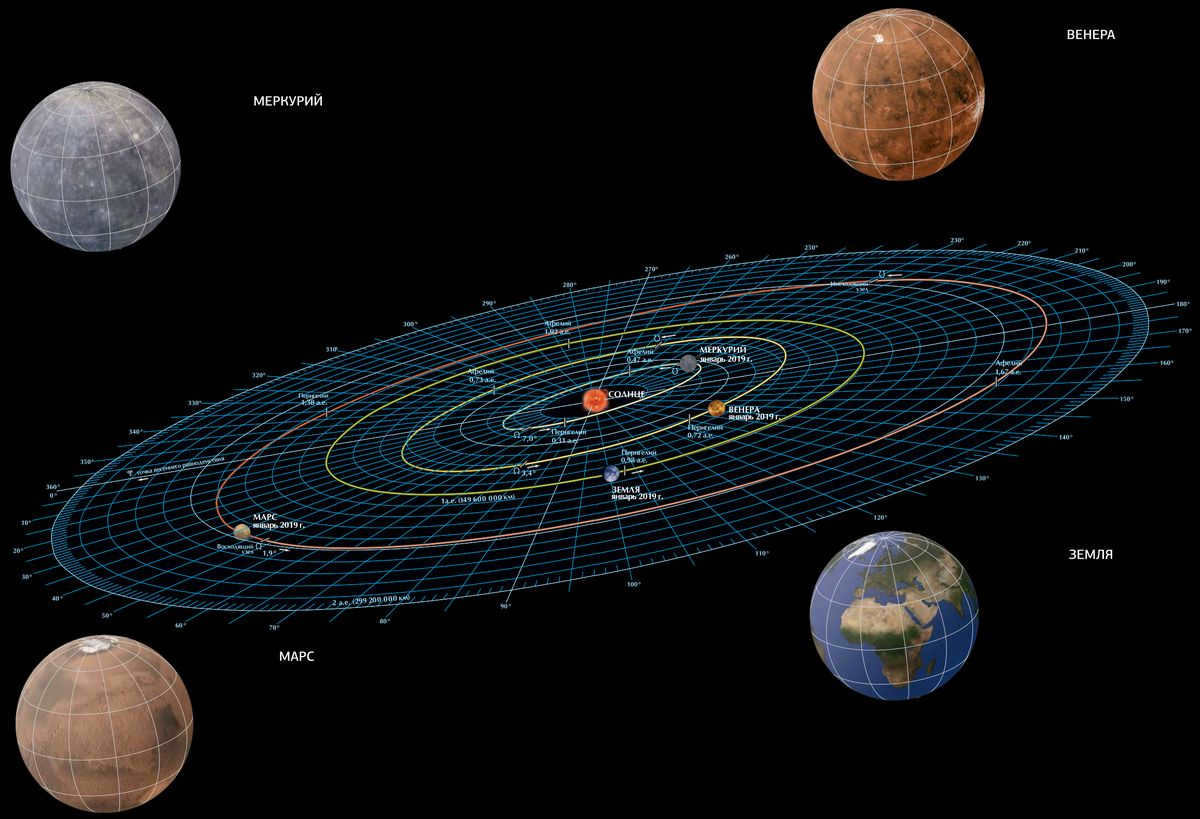
The orbits of the terrestrial planets in our solar system vary greatly in temperature. For example, Mercury experiences extreme temperature fluctuations as it zips around the Sun, with its hemispheres alternating between scorching heat and freezing cold. Venus, on the other hand, is a sweltering planet with an atmosphere that traps the majority of the Sun’s energy, resulting in a greenhouse effect similar to that of a massive greenhouse.
The planets outside the solar system
Meanwhile, a completely different situation was unfolding beyond the frost line. Due to the abundance of untouched materials, planetesimals developed at a faster rate and achieved a greater size compared to the planets in the Earth group. As a result of their immense masses, these entities were capable of capturing significant amounts of hydrogen and helium from their surroundings. Hence, these colossal planets are recognized as the largest in the entire solar system.
The subsequent development of the outer planets is a bit more intricate compared to that of the Earth-like planets. Jupiter and Saturn, the gas giants, formed rapidly as explained earlier, but the gas giants Uranus and Neptune seem to have formed later and closer to the Sun than their current positions. Additionally, they took shape during a time when the Sun released powerful streams of particles into space, which expelled most of the primary hydrogen and helium from the solar system. As a result, these two planets ended up being smaller in size. Furthermore, they have a distinct chemical composition from Jupiter and Saturn, leading them to be commonly referred to as ice giants rather than gas giants.
The four colossal planets, together with all the remaining planetesimals, along with various other objects, persistently continued their orbital motion, engaging in gravitational interactions with one another. According to calculations based on a theoretical model, Jupiter took shape towards the outer portion of what is now widely referred to as the asteroid belt. A series of intricate gravitational interactions between Jupiter, Saturn, and the remaining material in the protoplanetary disk instigated a succession of occurrences that astronomers commonly label as the Big tack (in reference to the strategic maneuvering of a sailing ship against the wind).
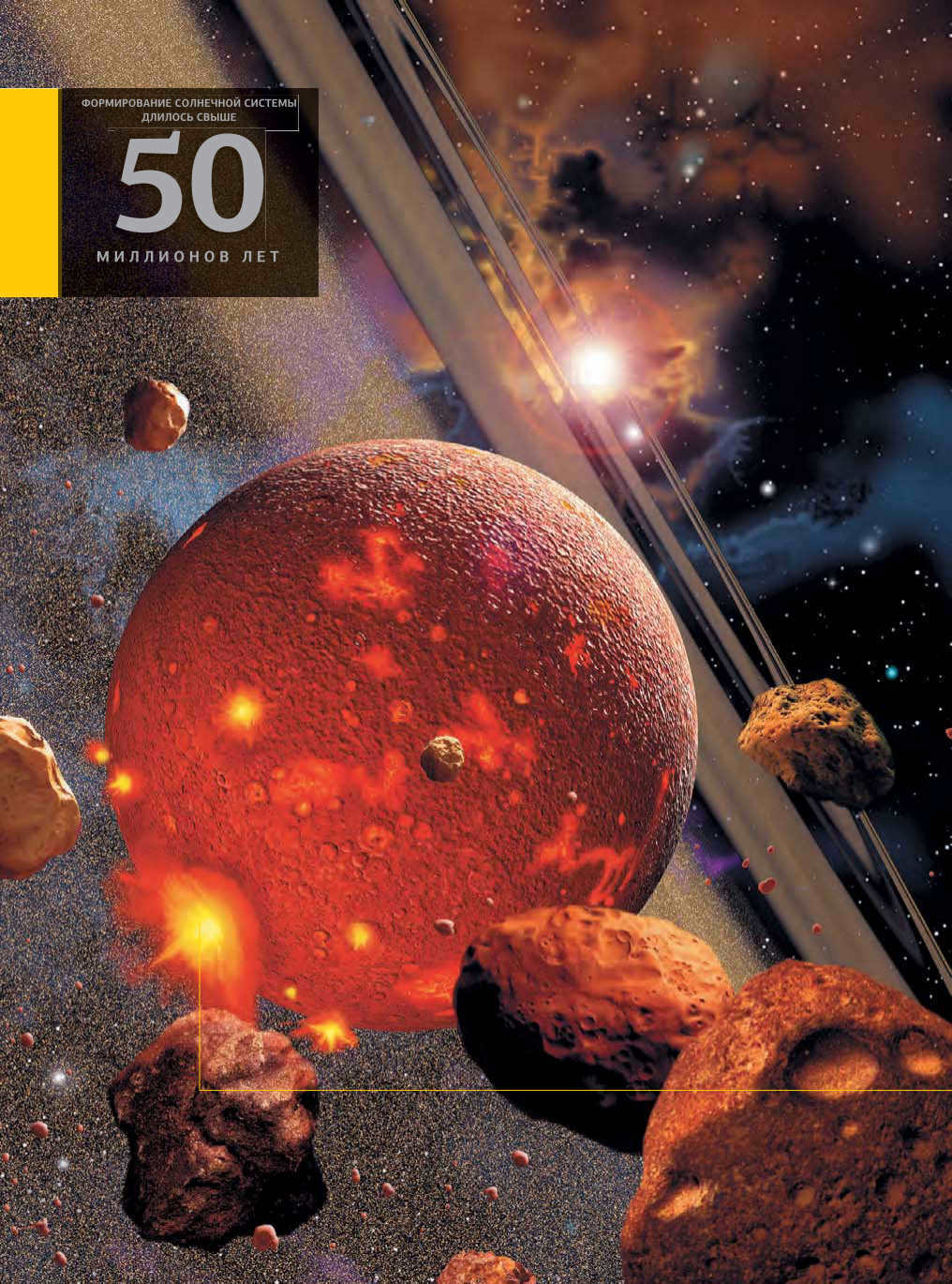
During the early stages of the solar system, the inner planets experienced a chaotic period of bombardment from numerous planetesimals. As a result, these planets underwent intense heating.
As a result of these maneuvers, Neptune’s orbit was pushed outward, causing it to collide with the remnants of the protoplanetary disk, similar to a bowling ball hitting pins. At that time, the disk had expanded to the size of Uranus’s current orbit, and by the end of the planetary migrations, the system had extended even further beyond Pluto’s current orbit.
This significant change in trajectory provides insight into various characteristics of the inner solar system. For instance, the substantial loss of matter from the protoplanetary disk explains why Mars is considerably smaller than Earth and Venus – its potential building materials were simply expelled from the solar system. This explanation also accounts for the limited amount of matter remaining in the asteroid belt.
The Late Heavy Bombardment was a result of numerous drifts that occurred over several hundred million years, leading to intense collisions among all the bodies in the inner solar system. The evidence of this period can be seen in the craters that still exist on airless bodies like Mercury and the Moon.
In recent decades, astronomers have come to realize that the early development of the solar system was far from the calm and orderly collapse envisioned by Laplace in the 18th century. However, once the initial chaos subsided, the solar system became a much more structured and predictable environment, which is essential for our future exploration of the universe.
To view a larger version of the picture, simply click on it. It will open in a new window for your convenience.
